-
Bartram’s scrub-hairstreak (Strymon acis bartrami), federally endangered
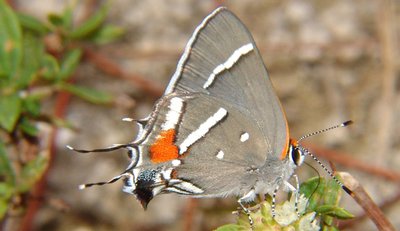 Courtesy USFWS
Courtesy USFWSFlorida-endemic Bartram’s scrub-hairstreak butterflies are found only in South Florida and on Big Pine Key in the Florida Keys. They have gray wings with broad white bands with black edges and a splash of orange. They rarely stray from their host plant, pineland croton (Croton linearis). Once abundant throughout Miami-Dade and Monroe counties, their habitat is now quite limited. They’re threatened by habitat destruction from urban development, invasive species, pesticides, collection, and effects of climate change like sea-level rise and storms of increasing intensity.
-
Eastern indigo snake (rymarchon couperi), federally threatened
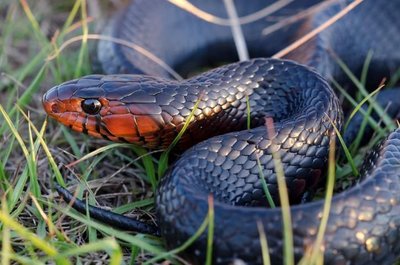 Courtesy USFS
Courtesy USFSDocile, nonvenomous eastern indigo snakes are the largest native snakes in North America, growing up to 9 feet long. They have lustrous blue-black scales, and some have rosy chins, throats and cheeks. Their scientific name means “lord of the forest,” which is fitting for a species that prefers dining on other snakes — even venomous ones. Indigo snakes can be found in various habitats across the Southeast, including pine rocklands. They are threatened by habitat destruction for urban and agricultural development, pesticides, disease, and climate change.
-
Miami tiger beetle (Cicindelidia floridana), federally endangered
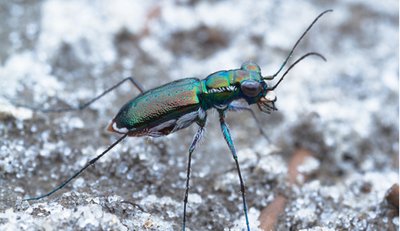 By Chris Wirth
By Chris WirthSmall but mighty, Miami tiger beetles were once considered extinct. Rediscovered in 2007 they’re currently known to exist in only two populations, both found in urban Miami-Dade County’s pine rocklands. These tiny beetles are no larger than a grain of rice and have iridescent green bodies. The greatest threat they face is habitat destruction for urban development, but they are also at risk from pesticide use and insufficient habitat management.
-
Florida bonneted bat (Eumops floridans), federally endangered
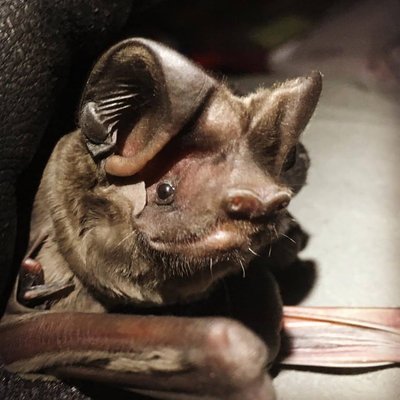 By Shalana Gray
By Shalana GrayCharismatic Florida bonneted bats are found only in South Florida in pine rocklands, cypress swamps and pine flatwoods. They are the largest bats in Florida and can be identified by their large ears, which extend over their faces like a bonnet. These bats are threatened by habitat destruction and degradation, pesticides and the effects of climate change, including sea level rise, storms of increasing intensity and “coastal squeeze” that occurs between human built environments and rising seas. The largest known population of Florida bonneted bats lives in the residual pine rockland forests in urban Miami-Dade County near Zoo Miami, a natural oasis amidst an encroaching sea of development.
-
Florida leafwing (Anaea troglodyte floridalis), federally endangered
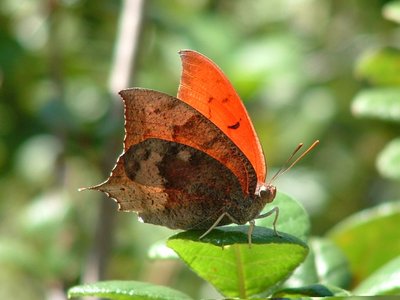 Courtesy Mary Truglio
Courtesy Mary TruglioExperts at blending in, Florida leafwings have wings with brown or gray undersides, to look like dead leaves. But when they fly, the brilliant red and orange topsides of their wings can be seen. Like Bartram’s scrub-hairstreak, the leafwing’s only known host plant is the pineland croton (Croton linearis). Once abundant throughout South Florida and the Keys, they’re now thought to currently occupy only Everglades National Park. The reasons for the declines are not fully known, but the biggest threats most likely include habitat destruction, invasive species, insecticide use and butterfly collecting. Ongoing and future sea-level rise also threaten its habitat.
-
Gopher tortoise (Gopherus polyphemus), state threatened
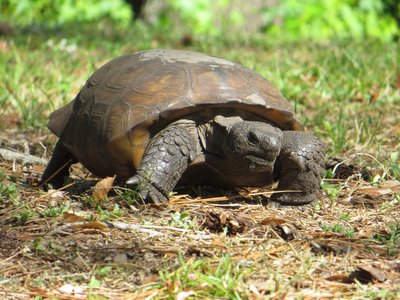 By Elise Bennett
By Elise BennettSlow and dependable, gopher tortoises are wild stewards of Florida’s pine forests and coastal dunes. With their shovel-like front legs and strong, thick back legs, they dig deep burrows that support more then 360 other species across their southeastern range. These tortoises are also seed dispersers, eating plants and fruits and carrying their seeds to new places. Pine rocklands in South Florida support one of the southernmost populations, and these gopher tortoises help support the diverse array of wildlife and plants in these rare forests. Threats facing the gopher tortoise include habitat destruction for urban development, disease, human persecution and climate change.
-
Key deer (Odocoileus virginianus clavium), federally endangered
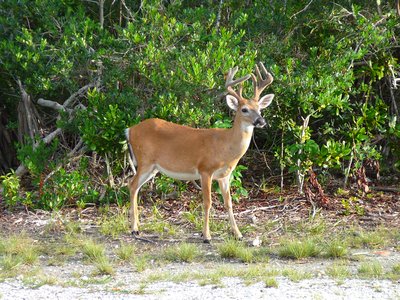 By Marc Averette/Wikimedia
By Marc Averette/WikimediaDiminutive Key deer are the smallest subspecies of white-tailed deer, reaching at most roughly the size of a large dog. They have adapted to their only habitat in the Florida Keys and can easily swim between islands. Historically Key deer were threatened by hunting; now they’re threatened by habitat destruction from development, road deaths, disease and effects of climate change like sea-level rise, which degrades habitat, and saltwater intrusion, which affects available freshwater for drinking.
-
Key ring-necked snake (Diadophis punctatus acricus), proposed federally endangered
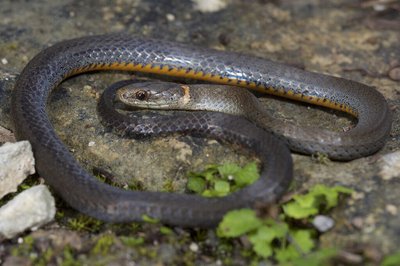 Courtesy USGS
Courtesy USGSTiny, delicate Key ring-necked snakes are found only in the lower Florida keys in pine rocklands and tropical hardwood hammocks. These small, nonvenomous snakes have grayish-black backs and brilliant yellow, orange and red bellies with rows of dark, half-moon spots. Unlike their close relatives on mainland Florida, Key ring-necked snakes lack the distinct yellow-orange ring around their necks. Ring-necked snakes are threatened by habitat destruction, sea-level rise, storms of increasing intensity, and predation by invasive fire ants.
-
Rim Rock crowned snake (Tantilla oolitica), proposed federally endangered
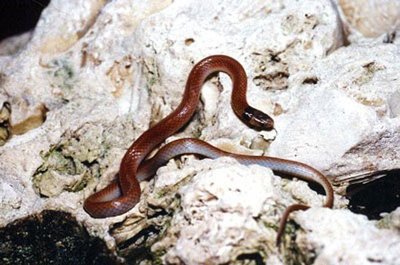 Courtesy FWC
Courtesy FWCSmall and slight, Rim Rock crowned snakes are adapted for living in the crevices of limestone rock and under debris on the forest floor. They have tan-colored bodies with a dark “crowned” head. These snakes are docile and will not even bite in self-defense. They are threatened by habitat destruction, fire suppression, and climate change.
Plants
-
Big Pine partridge pea (hamaecrista keyensis), federally endangered
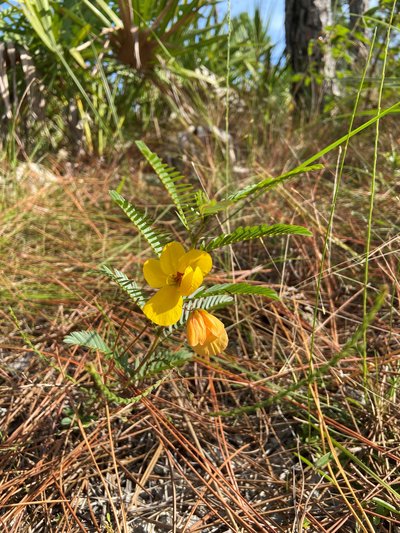 By Elise Bennett
By Elise BennettThese Florida-native shrubs are only found in the lower Keys in pine rocklands and nearby disturbed sites and roadsides. They have yellow flowers, with five buttercup-like petals and rosy-brown stamen, and compound leaves that are divided into mirrored leaflets. Their fruits are long, soft, fuzzy pods shaped much like those of a pea. Threats include habitat destruction and degradation from urban and agricultural development, invasive species, sea-level rise, and storms of increasing intensity.
-
Crenulate leadplant (Amorpha crenulate), federally endangered
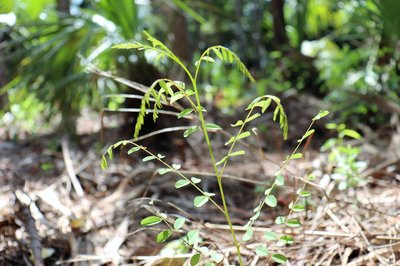 By Ana Lima
By Ana LimaThese deciduous shrubs are found in South Florida’s pine rocklands, pineland hammock edges, vacant lots, marl prairie, and other areas maintained by fire. They can grow up to five feet tall and have reddish purple branches with mirrored leaflets. Their white or lavender blooms grow on several erect flower spikes. Threats include habitat destruction and degradation from urban and agricultural development, invasive species and climate change.
-
Blodgett's silverbush (Argythamnia blodgetti), federally threatened
These perennial shrubs grow in pine rocklands, sunny spots within rockland hammocks and coastal berms, and along roadsides in South Florida and the Keys. They have woody bases with finely hairy stems and leaves, tiny green flowers, and rounded green fruits. Threats include habitat destruction and degradation, invasive species, sea-level rise, and storms of increasing intensity.
-
Carter’s small-flowered flax (Linum carteri carteri), federally endangered
These delicate-looking plants are found in pine rocklands in Miami-Dade County. They are annual herbs that produce distinctive, half-inch-wide flowers with five yellow-orange petals. When the flowers bloom, the petals shed by midday. Threats include habitat destruction and degradation from urban and agricultural development, invasive species, sea-level rise, and storms of increasing intensity.
-
Deltoid spurge (Chamaesyce deltoidea ssp. Deltoidea), federally endangered
These perennial herbs are found in pine rocklands in South Florida and the Florida Keys. They grow in mats formed by many wiry stems that grow from a taproot. Their name (deltoid) comes from the rounded triangular shape of their leaves, which are bright green and can be smooth or hairy. Threats include habitat destruction and degradation from urban and agricultural development, invasive species, and climate change.
-
Everglades bully (Sideroxylon reclinatum spp. Austrofloridense), federally threatened
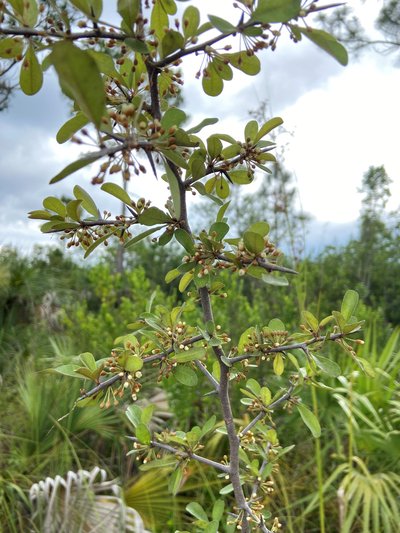 By Elise Bennett
By Elise BennettThese perennial shrubs are found in pine rocklands and marl prairies in South Florida. They grow 3-6 feet tall and have thorny branches and oval leaves with fuzzy undersides. Threats include habitat destruction and degradation from urban and agricultural development, invasive species, moving and herbicide use, and effects of climate change like sea-level rise and storms of increasing intensity.
-
Florida brickell-bush (Brickellia mosieri), federally endangered
These perennial herbs are found in South Florida pine rocklands. They grow not in soil but low-nutrient sand, marl and organic material found in limestone crevices. Tall and slender, they have white flowers that grow in small, dense heads. Threats include habitat destruction and degradation from urban and agricultural development and invasive species.
-
Florida pineland crabgrass (Digitaria pauciflora), federally threatened
These small, perennial clump-grasses are found in the seasonally flooded zone between pine rocklands and marl prairies in South Florida. These tall grasses grow 1-3 feet and appear blue-green to gray, with rusty brown stems. They have very small, dull-green flowers that grow on wispy spikes on the ends of their stems. Threats include habitat destruction and degradation from urban and agricultural development, invasive species, moving and herbicide use, and effects of climate change like sea-level rise and storms of increasing intensity.
-
Florida prairie clover (Dalea floridana), federally endangered
These perennial shrubs are found in pine rocklands, rockland hammocks, marl prairies, coastal berms and zones between these habitats in South Florida. They can grow from a few feet to nearly 10 feet tall and have woody stems with reddish branches bedecked with green leaflets and loose heads of white and maroon flowers with petals of different shapes and lengths. Threats include habitat destruction and degradation from urban and agricultural development, invasive species, moving and herbicide use, and effects of climate change like sea-level rise and storms of increasing intensity.
-
Garber's spurge (Chamaesyce garberi), federally threatened
These perennial herbs grow in south Florida’s pine rocklands, hammock edges, coastal rock barrens, grass prairies, salt flats, beach ridges and swales. They are softly hairy, have oval leaves, and grow wiry stems that can reach up to a foot long. They also have small, cup-like structures that hold small flowers. Threats include habitat destruction and degradation from urban and agricultural development, invasive species, and climate change.
-
Pineland sandmat (Chamaesyce deltoidea spp. pinetorum), federally threatened
These perennial herbs are found in pine rocklands in South Florida. They have small, delicate, fuzzy leaves that grow from rosy stems in rounded triangle or kidney shapes and unbelievably small flowers. Threats include habitat destruction and degradation from urban and agricultural development, invasive species, moving and herbicide use, and effects of climate change like sea-level rise and storms of increasing intensity.
-
Sand flax (Linum arenicola), federally endangered
These perennial herbs are found in pine rocklands, marl prairies, and adjacent disturbed areas in South Florida and the Florida Keys. They have small, brilliant yellow, buttercup-shaped blooms that grow at the end of long, wiry stems and drop their petals soon after blooming in the morning. Threats include habitat destruction and degradation, invasive species, sea-level rise, and storms of increasing intensity.
-
Small's milkpea (Galactia smallii), federally endangered
These perennial herbs are found in South Florida’s pine rocklands. They have trailing stems, pale pink to purple flowers, and hairy pods. Threats include habitat destruction and degradation, invasive species, sea-level rise, and storms of increasing intensity.
-
Tiny polygala (Polygala smallii), federally endangered
These perennial herbs are found in pine rocklands, scrub, sandhills, and coasts. They have yellow-green flowers and unbranched stems that make them look tufted. Threats include habitat destruction and degradation, invasive species, sea-level rise, and storms of increasing intensity.
-
Wedge spurge (Chamaesyce deltoidea serpyllum), federally endangered
These perennial herbs are found in only in pine rocklands and along roadsides on Big Pine Key in the Florida Keys. They have slender, wiry stems that radiate out from a taproot and tiny triangular to oval leaves covered in a fine fuzz that makes the plant look silvery. Threats include habitat destruction and degradation, invasive species, sea-level rise, and increasingly intense storms.